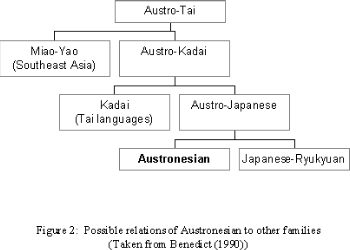|
The Austronesian Language Family
Nate Blaylock Austronesian is a family of languages spanning from Southeast Asia to the westernmost islands of the Pacific. Austronesian is not only geographically large, but it also contains over 1200 of the world's languages (SIL 1996). In this paper I will briefly look at the history and colonization of the areas where Austronesian languages are spoken. I will then give a description of the language family with its sub-groupings. Finally, I will discuss possible connections with other language families. History
Humans are thought to have been on the main Indonesian islands and New Guinea from before 30,000 B.C. From there, in about 1500 B.C., two groups from Indonesia and New Guinea began colonizing Micronesia and Melanesia respectively. It was not until much later (500 B.C. - 500 A.D.) that Polynesia was colonized by these people. (Irwin 1992, 5-6) As these people spr ead further out, they had less and less contact with each other. Over thousands of years, separate dialects developed into distinct languages. Sub-groupings The sheer number of languages in Austronesian (over 1200 as mentioned above) and lack of written records has made it difficult to create a grouping that enjoys a general consensus. The status of even some meta-families is not always agreed upon (see Benedict 1990, SIL 1996 for examples). In figure 1 I have provided a simplified family diagram taken from the Summer Institute of Linguistics Ethnologue web page. These general groupings are not without dispute, but they should be sufficient for the purposes of a general paper of this nature.
Figure 1 shows the major sub-groupings of Austronesian. At the top level, it is split into two families: Formosan and Malayo-Polynesian. Formosan is the group of (non-Chinese) languages found on the island of Taiwan, and includes 23 languages (SIL 1996). Malayo-Polynesian is split into Central, Eastern, and Western branches, with Central and Eastern linked at an intermediate node. Central Malayo-Polynesian is spoken mainly in eastern Indonesia (Benedict 1990) and consists of 149 languages (SIL 1996). Eastern Malayo-Polynesian is a family of over 500 languages (SIL 1996). This includes a great number of languages in Papua New Guinea, as well as most languages spoken on the islands in Melanesia, Micronesia, and Polynesia. A sister to the Central-Eastern branch, Western Malayo-Polynesian encompasses the Filipino languages, as well as a scattering of Indonesian and Micronesian languages. It also has over 500 languages (SIL 1996).
Possible Connections Several suggestions have been made as to what other language families Austronesian is related to. Figure 2 shows one such hypothesis, put forward by Benedict (1990). In his book, he attempts to show a common mother - Proto-Austro-Japanese for Austronesian and Japanese. This mother then fits in with Kadai and eventually Miao-Yao to form an Austro-Tai family. Austronesian is typically thought to fit into this framework, although it is unclear if Japanese is related to Austronesian, or if it is a part of the Altaic family.
Schuhmacher, et al. (1992) suggest a possibly different (or even related) connection of Austronesian. They suggest that the Oceanic Austronesian speakers must have also colonized South America. They say it would be "impossible indeed that tiny specks of land in vast expanses of the Pacific could be repeatedly and habitually reached by locals, but the latter were not supposed to know anything about the American continent towering right in front of them, like a mighty mountain, from pole to pole." (p. ix) They are presently trying to systematically catalog and find a link between Austronesian and the languages of South America, although they admit that they are at the very beginning of their study. If this turns out to be true, some of the South American language families may be categorized either as sisters or daughters to Austronesian.
Austronesian is a fascinating and very complex language family. It encompasses a very wide geographic area and a numerous amount of languages. Despite the difficulties of categorizing these languages, much work has been done to sort the many languages into language families and sub-families. Works Cited Benedict, P. 1990. Japanese / Austro-Tai. Karoma: Ann Arbor. Irwin, G. 1992. The Prehistoric Exploration and Colonisation of the Pacific. Cambridge. Schuhmacher, W., et al. 1992. Pacific Rim: Austronesian and Papuan Linguistic History. Carl Winter Universitätsverlag: Heidelberg, Germany. Summer Institute of Linguistics (SIL) 1996. "Ethnologue" Online posting. http://www.sil.org/ethnologue/ (24 Feb. 1999) |
Department of Linguistics
Brigham Young University
Last Updated: Monday, September 6, 1999

